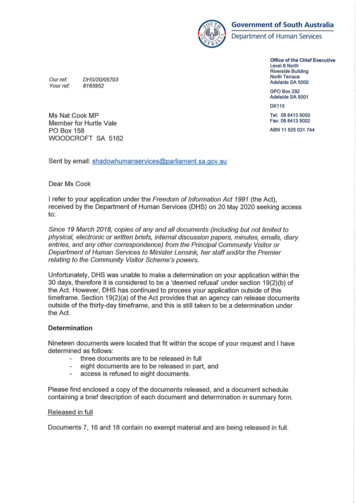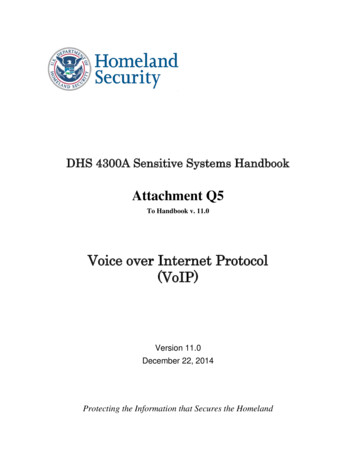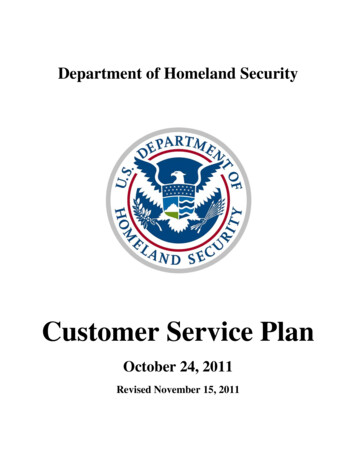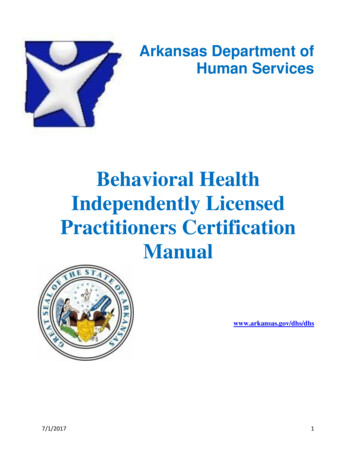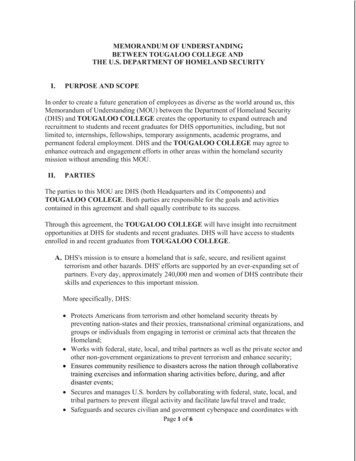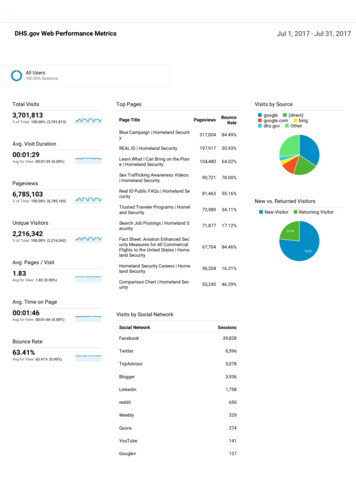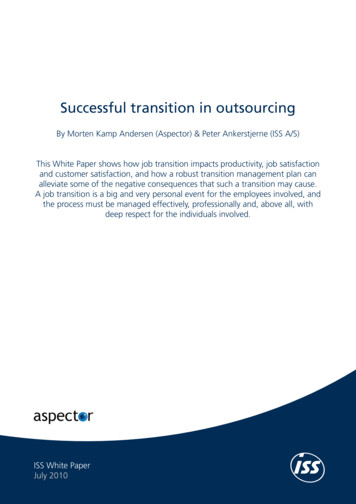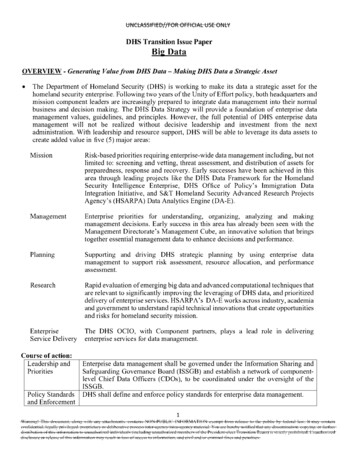
Transcription
iDHS Transition Issue PaperBig DataOVERVIEW - Generating Value from DHS Data — Making DHS Data a Strategic Asset The Department of Homeland Security (DHS) is working to make its data a strategic asset for thehomeland security enterprise. Following two years of the Unity of Effort policy, both headquarters andmission component leaders are increasingly prepared to integrate data management into their normalbusiness and decision making. The DHS Data Strategy will provide a foundation of enterprise datamanagement values, guidelines, and principles. However, the full potential of DHS enterprise datamanagement will not be realized without decisive leadership and investment from the nextadministration. With leadership and resource support, DHS will be able to leverage its data assets tocreate added value in five (5) major areas:MissionRisk-based priorities requiring enterprise-wide data management including, but notlimited to: screening and vetting, threat assessment, and distribution of assets forpreparedness, response and recovery. Early successes have been achieved in thisarea through leading projects like the DHS Data Framework for the HomelandSecurity Intelligence Enterprise, DHS Office of Policy's Immigration DataIntegration Initiative, and S&T Homeland Security Advanced Research ProjectsAgency's (HSARPA) Data Analytics Engine (DA-E).ManagementEnterprise priorities for understanding, organizing, analyzing and makingmanagement decisions. Early success in this area has already been seen with theManagement Directorate's Management Cube, an innovative solution that bringstogether essential management data to enhance decisions and performance.PlanningSupporting and driving DHS strategic planning by using enterprise datamanagement to support risk assessment, resource allocation, and performanceassessment.ResearchRapid evaluation of emerging big data and advanced computational techniques thatare relevant to significantly improving the leveraging of DHS data, and prioritizeddelivery of enterprise services. HSARPA's DA-E works across industry, academiaand government to understand rapid technical innovations that create opportunitiesand risks for homeland security mission.EnterpriseThe DHS OCIO, with Component partners, plays a lead role in deliveringService Delivery enterprise services for data management.Course of action:Leadership andPrioritiesPolicy Standardsand EnforcementEnterprise data management shall be governed under the Information Sharing andSafeguarding Governance Board (ISSGB) and establish a network of componentlevel Chief Data Officers (CD0s), to be coordinated under the oversight of theISSGB.DHS shall define and enforce policy standards for enterprise data management.1ARinal.LiAltn 1.,,L11.111 1111.M11,1.11.PTiall ,11.1011TLJ11111,pRIMIDILLM1IR1112M11
icationsThe Department must ensure that it complies with all legal and policy requirementsin the maintenance collection, storage, use, dissemination, archival and disposal ofits data (e.g., Privacy Act of 1974,5 U.S.C. § 552a).S&T leads the Department's efforts to innovate and evaluate emerging big datasolutions and related technologies to provide technical guidance, consultation andpotential solutions for missions of Homeland Security Enterprise.DHS carefully develops, leverages and deploys efficient technologies to meetcurrent data management needs. The DHS OCIO, with Component partners, willplay a key role in delivering enterprise services for data management.DHS effectively communicates, and understands, the value of data management,from not only leadership, but from operators, analysts and planners who know whatthey need from our DHS data.DETAILED DISCUSSION As the DHS Data Strategy directs, DHS Enterprise Data Management must be directly tied toour strategic, mission priorities as a Department. The FY2017-2021 DHS Data Strategy provides a foundational set of principles and guidelinesthat can be used to efficiently drive data management. DHS S&T works directly with industry, academia and other government organizations tochallenge, understand, leverage and adapt rapidly changing technologies to meet homelandsecurity mission needs such as self-service data, virtualized data collection, point and click datawrangling, geo-coding, entity resolution, social media analytics, real-time intelligent systemsand automated reporting in a manner that is consistent with legal authorities and privacy, civilrights, and civil liberties policies, and adequate intellectual property rights. The DHS OCIO works directly with all members of the homeland security enterprise to captureprioritized, mission requirements for data management, and then, leveraging thegroundbreaking research and development of S&T, partners with the enterprise to deliveressential services and platforms.Issue Background DHS manages significant data holdings across a broad set of missions and activities, many ofwhich are public facing and occur in a rapidly evolving threat environment. With the establishmentof the Department in 2002, each of its legacy Components retained ownership and management ofits own data, often with decentralized data systems supporting the various operational missions ofDHS.As such, DHS data is complex and must be managed appropriately. This includes ensuring thatthe Department protects the privacy, civil rights and civil liberties of individuals whoseinformation we maintain. This also includes ensuring that the Department obtains adequateintellectual property rights to meet its missions.Current data management challenges and gaps include, but are not limited to:Keeping pace with enterprise wide, cross component, mission needs;Different policies on how to maintain what is otherwise similar data.1? Development of intelligence insights from multiple transactional screening systems;2
Analysis and reporting of immigration and other statistics across multiple immigrationand other data systems that are not necessarily linked;Strengthening and maturing the oversight of DHS finances and spending; and' . Bottlenecks in hiring of human capital resources to address operational gaps.In order to provide strategic value to the homeland security enterprise over the next four (4) years,DHS will need to operationalize the principles of the DHS Data Strategy, focusing on strategicpriorities for Mission, Management, and Planning.Course ofAction — Moving from Data Mana ement Principles to Data Mana ement ExecutionFirst and foremost, we need a way to set our data management prioritiesLeadership,to link our business and mission needs to our data needs. In practice, thisGovernance andmeans establishing a DHS enterprise-wide management role that isPrioritiesoperated at the highest levels of the Department. This entity will listen tothe real-world needs of our operators, our analysts, our managers, and ourplanners, and obtain decisions on the priorities from our Department seniorleadership. Further, it will ensure that DHS has the agility and flexibility toapply its limited resources on a prioritized, risk-informed basis. Thisoversight should be led by the Information Sharing and SafeguardingExecutive and supported by a network of component level Data Officers,in turn supported by a network of data scientists and managers.Second, DHS must set and enforce pragmatic data and data science policyPolicy Standardsstandards that efficiently create manageable network effects across DHS& Enforcementstrategic data sources. These standards will make it easier for data ownersto adopt and lead to improved accessibility for authorized use at the scaledemanded by homeland security applications.Third, we need to ensure that Department-wide, our enterprise dataCompliancemanagement priorities, methodologies, uses and implementation controlsare in line with legal authorities, and, privacy, records management, civilrights and civil liberties laws and policies, and adequate intellectualproperty rights.Fourth,technology evolves at a rapid pace requiring that DHS quicklyR&Dassess and understand both opportunities and threats that emerge from newcapabilities. DHS S&T hosts an internal Data Analytics Engine (DA-E)laboratory where DHS components and the Homeland Security Enterprisecan examine the impact of emerging technology on current and futuremissions. This consolidated research and development activity makesexperimentation, prototyping and piloting of technology efficient in amanner where lessons learned and best practices can be easily shared acrosshomeland security organizations.Fifth,the DHS OCIO manages a series of enterprise services and platformsEnterprise Servicewhich, in direct partnership with DHS components, actively seek out andDeliverydeliver on the prioritized requirements of the homeland security enterprisefor mission-based data management solutions.Sixth, we need clear communication of priority technical, policy andCommunicationsmanagement directions to DHS executives, managers, and most3III; Th. Lh MI LaNON PI 13L1NI 0EO110110N-
importantly analysts, responders, and operators to effectively implemententerprise data managementMajor Risks What Happens if We Don't Make Data a Strategic Asset at DHS? DHS risks generating huge inefficiencies, and associated financial costs, in how data arecollected, shared, transferred, and used, with components creating their own, walled offdata management solutions. DHS risks using data in inappropriate and illegal ways DHS risks not achieving our actual mission and obligations to the American people byfailing to identify and mitigate a security threat, missing a vital lead or a critical link, orfailing to deploy an essential asset. Without rapid assessment and deployment oftechnology, DHS systems can quickly become ineffective against sophisticated threats.Key Partnerships Intelligence Community Other Federal agencies1- State, Local, Tribal, Territorial stakeholders'1-- International partners1- Non-Governmental Organizations Public / Private agencies1.-- Data Analytics and Advanced Computing Industry1.-- Computer Science, Engineering, Math and Science Academic Organizations4VrtflThLARIAL,ARIN N FN BLI NI ORM NT )N AIA likIA
348Science and TechnologyThe Science and Technology Directorate is the primary research and development ann of theDepartment. It provides federal, state and local officials with the technology and capabilities toprotect the homeland.The Under Secretary for Science and Technology acts as the principal science and technologyadvisor to the Secretary and his/her Cabinet.S&T has resident scientific expertise and capabilities in the following domains including, but notlimited to: Situational Awareness and Decision Support Engine (SANDS)Communications & Networking Engine (CNET)Data Analytics Engine (DAE)Identity & Access Management Engine (IDAM)Behavioral, Economic & Social Sciences Engine (BESSE)Modeling & Simulation Engine (MSE)Manufacturing Engine (MANE)Mission & Operational Systems AnalysisTest and EvaluationApplication of StandardsSystems Engineering & TransitionHuman Systems IntegrationArchitecture EngineeringTechnology Foraging & OpExTech Transfer & CommercializationPartnership CoordinationSponsored R&DIntellectual Property Management
349S&T owns and operates national laboratories which perform research and scientific and forensicanalysis. S&T works with the broader R&D community to identify and adapt existing R&Dinvestments to meet operator needs and challenges in four general areas: Technological capabilities for addressing DHS operational and strategic needs or that arenecessary to address evolving homeland security threats. Systems-based analysis for introducing streamlined, resource-saving process improvementsand efficiencies to existing operations. Improvements for enabling more effective and efficient operations and avoiding costlyacquisition failures and delays by leveraging S&T's technical expertise to improve projectmanagement, operational analysis and acquisition management. Opportunities for collaboration across departmental, interagency, state and local andinternational boundaries to advance knowledge and understanding of existing and emergingthreats and help identify a path forward.From border security and biological defense to cybersecurity and explosives detection, S&T is atthe forefront of integrating R&D across the public and private sectors and the internationalcommunity. By working directly with responders and component partners across the nation, S&Tstrives to provide advanced capabilities and analytics to better prevent, respond to and recover fromthe major threats to homeland security.MissionS&T's mission is to deliver effective and innovative insight, methods and solutions for the criticalneeds of the Homeland Security Enterprise.
KeyNon-Career or Career PositronCareerActing CareerNon-CareerActing Non-CareerSenate Confirmed "' Reports to DGCDirector of Support to theHomeland Security Enterpriseand First RespondersDaniel CotterUreore SECRETARY FORDirector of HomelandSecurity Advanced ResearchProjects AgencyDr. Patrick CarrickDirector of Administrationand SupportLisa Douglas-NaughtonOffice of Corporate— CommunicationsWendy HoweCapability DevelopmeSupport GroupSteven HutchinsonDRPUIT Under SecreteDr. Robert GriffinDr. I Reginald BrothersDirector of Finance andBudgetCarol &IUDsChief ScientistDr Pahl& Carrick.Science & Technology DirectorateDirector of ResearchDevelopmentJoseph Martinecunve SecretaryDiane S undeNChief of StaffKathryn CoulterOrganization Chan
351BudgetTotal Budget Authority 776,653,000-17,910,000 758,743,000FY17 PRESIDENT'S BUDGET - COMMONAPPROPRIATION STRUCTUREOperations &Support, 278,733,00037%Research &Development, 469,869,000Procurement,Construction, &Improvements,62%510,141,0001%584T - 5-Year Funding Trend 1,220,079,000 1,400,000,000,087,931,000 1,200,000,000 776,653,000 1,000,000,000T58743,000 800,000,000 600,000,000 400,000,000 200,000,00011 5FY13FY14FY15FY16Total Budget Authority"I IR'L TryP01 IATE ONFY17 PB
352Workforce4804773 / 1%Workforce ChartScience and Technology Directorate( iotaIslFit Authorized/Funded 440FTP Onboard - P (current/projected) -3FTP Onboard - C (current/projected)- 4771480Vacancy - P (current/projected) -Fm Authenzed1Fundecl. 36FT.Onboard P (curreneprojecteel) 313FTP Onboard - C (currenVercjected) 33/33Vacancy - P current1projecteed) Vacancy -C (cuman4projec1ed1. 0Total Vacancy rale (curreneprojecled1 0%SDFit Autonzechrunded 54FTP Onboard C (ourrent/projectecll6444Vacancy -C (currentrprojecled1 010744a1 Vacancy rate (currenlipropecte4/0%Fit AuthenzedlFunded 538112 Onboard C lcunent1prolecled1 2)53Vacancy - C (curren4pecy acted) 110Total Vacancy rale {cement/projected}2%Fit Authorized/Funded. 42F1D Onboard -C (curren4prolecD411 42142FIE Authorized/8 unded1 32FIP Onboard -C (currenVprojecle4132132Total Vacancy rate (curreritIpFojected)Total Vananny at icurren4projected)Fit AuthonzedIF ended 68FTP Onboard - C (current1prelected167163Vacancy - C (current/peDected) 110Total Vacancy rate (cunenVprojecte4/1%NO I ES d There are no set number of author! cci po 'Irons bygroup " PrOjeClinn may changc. ii BRNF rrancfp c,nes noroccuiFrEs)SELT - 5-Year Workforce Trend455480)1/L)4704624654(y.)4-55450FY131- 116Full Time EquNdleril.1- 111 PBFIE Author' rethrundeel 185F7P Onboard - C {currenVprojec1e4}1841186Vacancy - C (cunenepreseteell 110Total Vacancy rate (cunentDmientedl
353Strategic Priorities DHS R&D Coordination and Prioritization through Integrated Product Teams (IPTs):With increased, complex threats, in an austere fiscal environment, we must be strategicabout our R&D work and how we prioritize our investments. The IPT process, managed byS&T and staffed by the components, will improve acquisition across DHS by identifyingtechnological capability gaps and coordinating R&D to close those gaps across theDepartment's mission areas. Through an integrated investment process, S&T will explicitlytie its investments to specific areas, including: Presidential-national, Departmental, andother priorities as they arise. Advancing Cyber & IT Security: Cyber adversaries have presented a full spectrum ofthreats not only to the U.S. government, but also to private organizations and criticalinfrastructure sectors. All systems must be protected, and have processes in place to obtainand implement upgrades in real-time to secure mission-critical systems. S&T partners withnational and international leaders in cyber security to leverage our resources and capabilitiesfor optimal results. Keeping Pace with Technology: Government's ability to discover and implement newtechnologies is commonly outpaced by adversaries and the private sector. Processes foracquisition and security, for example, are typically not designed to keep up with the rapidpace of technology, leaving little choice but to manage unaddressed threats with inadequate,last-generation tools. Through S&T's technology foraging, operational experimentation,unique partnerships, research and development agreements between governments and theprivate sector, prize challenges, accelerators and public outreach, we are better positioned toaddress gaps in capabilities by mobilizing the Homeland Security Industrial Base. Energize the Homeland Security Industrial Base in support of providing leading,cutting-edge solutions to operational Components and first responders. Because DHShas largely utilized commercially available, off-the-shelf products to achieve its mission,partnership with industry is essential. We are striving to create a private sector communityaround homeland security challenges that sees the DHS mission as a joint mission. The useof prize challenges, accelerators, public outreach and other vehicles has generatedsignificant interest in the private sector in being part of a Homeland Security IndustrialBase. Support technology assessments for all major acquisitions in the Department to ensuretechnical maturity: S&T conducts a systems engineering review and technologyassessment of the technical solutions in DHS major acquisition programs and provides areport to the Chief Acquisition Officer and Joint Requirements Council prior to the decisionto enter the -Obtain" phase of the Acquisition Life Cycle. Integrated with the IPTs, thisensures that S&T is involved early in the acquisition process to assess the technical maturityof the technologies that DHS major acquisitions intend to acquire. S&T is poised to play alarger role in this mission space. Integrating Technology as an Element of Change to all Risk and Threat Calculations:All risk and threat calculations take current or next-generation technologies into account, yet, NON I NINTH NrA-TE INLy(1, [AL,ET
354few run the same calculations on potential future threats. By doing this, we can keep up withthreats but not get ahead of what is to come. S&T will look to provide this future viewthrough supporting technological risk assessments of Technology Readiness Levels 3, 4, 5,and more generations down the road. Instilling a Homeland Security Enterprise Approach since Threats Know No Borders:Today's threats come in all shapes and sizes, yet none are restricted by borders. Therefore,detecting and managing these threats must be done in partnerships that cross governmententities, state/local/federal jurisdictions, and international borders. S&T scouts opportunitiesto build solutions directly with the operational front lines of homeland security. Establish the future National Bio- and Agro-Defense Facility (NBAF), and itssupporting enterprise-wide ecosystem, as the leading biocontainment facility for thestudy of foreign animal and emerging zoonotic diseases that threaten animalagriculture and public health in the United States: The first laboratory facility in theUnited States of its kind, this 1.2 billion facility will allow researchers to study zoonoticdiseases that affect livestock and other large animals. In preparation for its completion in2022, S&T is focusing on construction of the 570,000 square-foot biocontainment facilitywith leading-edge capabilities and security; transition planning of operations from the PlumIsland Animal Disease Center (PIADC) in New York; and the creation of an ecosystem thatattracts partners and fosters innovation to tackle the biggest threats facing our animalagriculture. Shape a Workforce Culture Specifically Formulated for R&D: A workforce specificallyfocused on R&D is composed of very different attributes than that of operationalorganizations. Achieving the required skills, mindset, and balance/composition of the teamare all critical to its success. S&T will craft a workforce plan and build its workforce bycontinuously reviewing and mining data to inform hiring and development investments inthe near term, and yield the right mix of knowledge, skills and capabilities over the longterm that will be necessary to accomplish our R&D mission
355Key ency RelationshipsDescriptionS&T partners with many agencies acrossgovernment to support its missionsoperating laboratories and Centers ofExcellence, interfacing with the intelligencecommunity, identifying capability gaps andrequirements, and supporting test & evaluationin areas such as explosives, CounterUnmanned Aerial Vehicles, and FirstResponders.Stakeholder Groups and Federal Advisory Committees (FACA)PartnerDescriptionS&T's Homeland Security Science &S&T manages its own FACA compliantTechnology Advisory Committeeadvisory committee that is comprised ofcitizens from academia, the private sector, andformer governmental officials. The USSTutilizes the HSSTAC to assist in bringing innew opinions and ideas to foster the besteffectiveness and direction of the Directorate.S&T partners with multiple stakeholder groupsStakeholder Groupsin various topic areas such as first responders,communications, preparedness, explosives, andintelligence. These partnerships are helpful toidentify requirements, assess needs andcapability gaps, conduct operational fieldassessments, and collaborate with the largercommunity.Industry / Public-Private / AcademiaPartner NameDescriptionAcademic InstitutionsS&T establishes and manages the DHS Centersof Excellence and partners with other academicinstitutions in support of projects and programssuch as Small Unmanned Aerial Systems.Industry RelationshipsS&T partners with industry for technologytransition, conducting pilots, developingtechnologies, supporting the TransportationSecurity Laboratory and many importantprograms and projects within the Directorate.
356Intemationa EngagementsPartnerInternational Agreements/RelationshipsDescriptionS&T works with many countries via bilateraland other agreements to leverage internationalresources in the science and technology, andresearch and development community.Legislative Priorities Other Transactional Authority (OTA). Currently, OTA is set to expire with the end ofthe Fiscal Year on September 30, 2016. In the past, it has been renewed via the annualappropriations bill. S&T leadership has been working with authorizing committees to insertlanguage that would extend OTA by five years and provide stability for the programs thatuse it. Personnel Hiring. Section 1101 of the Strom Thurmond National Defense AuthorizationAct for Fiscal Year 1999(5 U.S.C. 3104 note; Public Law 105 261) provides fora specialhiring authority for agencies to bring onboard personnel with highly specialized andleadership backgrounds for select positions. Currently, per the Homeland Security Act of2002, this authority resides with the HSARPA Director. S&T is seeking legislation whichwould move that authority to the Under Secretary for Science and Technology. Integrated Product Teams (IPTs). At the direction of Secretary Johnson, the IPTs werere-instituted by Under Secretary Brothers as a way for S&T to assist operational componentswith determining their technology requirements and planning for the long-termimplementation of technological solutions. S&T is seeking legislation that wouldspecifically call out the IPTs to ensure the long-term viability of this critical mechanism. R&D Funding. By nature, R&D necessitates different funding structures thaninfrastructure. For successful R&D programs to truly deliver disruptive, impactful productsfor operators, they must be funded with an eye toward consistency over the term ofdevelopment. Infrastructure, on the other hand, is funded annually and can be managed assuch. Therefore, S&T is seeking to earn an understanding that R&D funding needs to beseparated from infrastructure funding so the very different needs of each can be applied. National Rio and Agro Defense Facility (NBAF). Due to the heavy investment whichUSDA is making in the agricultural threat, DHS and USDA have begun preliminarydiscussions as to which agency should manage the NBAF once it becomes operational.Although S&T is not seeking any legislative action at this time, the Senate mark up of boththe DHS and Agriculture Appropriations Bills included language for S&T and USDA tohave these discussions.
357Government Accountability Office / Office of the Inspector GeneralAuditsTitleMicrobial Forensics: DHS andFBI Biological AttributionCapabilities (Engagement Code460639)Multiplex Point-of-CareTechnology (Engagement Code100311)TitleReview of the DHS Science andTechnology Directorate'sEfforts to Protect InformationSystems from Insider ThreatsOIG Project No. 15-107-ITAS&TGAO AuditsDescriptionObjective to answer the following questions:(1) How have the DHS and FBI assessed thetechnical and scientific needs for attributionof a biological attack since 2010? (2) Whatscientific and technical gaps remain, if any,in DHS and FBI capabilities to attribute thesource of a biological attack, including anattack using a novel synthetic biologicalweapon?The committees seek to do an assessment ofmultiplex point-of-care technology (POCT)to address the following: (1) Has youragency funded work to develop or test suchtechnologies, and if so, at what stage ofdevelopment or testing is the technology, andwhat are the known performancecharacteristics (for example, sensitivity,specificity, and limits of detection) of thetechnology? (2) What is known about theperformance characteristics of multiplexPOCT in the industrial sector? (3) Whattechnical issues are associated withmultiplexing assays used in suchtechnology? (4) What are the knownbenefits, costs, and implementationchallenges of this technology?GIG AuditsDescriptionThe objective is to determine the current riskby assessing the effectiveness of steps S&Thas taken to protect its IT assets and datafrom potential unauthorized access,disclosure, or misuse by its employees,contractors, and business partnersespecially those with special or elevatedaccess based upon their job descriptions orfunctions.Final ReportDue11/15/20164/10/2017Final ReportDueAudit OnHold as of10/21/2015
, 2 -DHS Transition Issue PaperResearch and Development ProfileOVERVIEW Many of the Department of Homeland Security's (DHS) 240,000 employees are on the frontlines addressing border and maritime security, immigration, disaster response, or protectingthe nation's leadership. The Department also provides support for its vast homeland securitynetwork at the state, local, and tribal levels. As such, the DHS research and development(R&D) profile is modeled to serve this customer base with solutions that link directly to theirtechnological needs. DHS has three entities appropriated to conduct R&D- the U.S. Coast Guard (USCG), theDomestic Nuclear Detection Office (DNDO), and the DHS Science and TechnologyDirectorate (S&T).' S&T coordinates R&D efforts across the Homeland Security Enterprise (HSE), whichincludes DHS Components and others with a homeland security mission. USCG conducts research across all eleven USCG statutory mission areas. This includes jointresearch, development, and testing with the Department of Defense (DoD). DNDO focuses its R&D on national detection and forensics technologies and capabilities fornuclear and radioactive materials. DHS works closely with Components to transition solutions into the field through acoordinated R&D approach that best serves DHS and the HSE. The Under Secretary for S&T serves as the science advisor for the Secretary to provideguidance on current and emerging threats and provides mitigation strategies. The Director of DNDO advises the Secretary regarding R&D efforts and priorities related toradiological and nuclear detection and countermeasures in support of the Department'smissions. S&T contributes to the Unity of Effort by coordinating R&D across the Department toinform a wise investment strategy and realize efficiencies across Components.DETAILED DISCUSSIONRole of DHS in R&DWithin DHS, R&D is predominantly performed by the Science and Technology Directorate, theU.S. Coast Guard, and the Domestic Nuclear Detection Office. USCG and DNDO have specificmission areas of focus while S&T maintains a broader scope of R&D to support the Departmentand HSE at large, which can include the private sector and first responders who also have a stakein homeland security. As the mission space is vast across DHS and the HSE, S&T, USCG, andBeginning in FY2017, additional Components and Directorates will have R&D funding under the CommonAppropriation Structure (CAS). These include the Transportation Security Administration, National Protection &Programs Directorate, United States Secret Service, and the Under Secretary for Management. Reforms under theCAS have resulted in greater transparency of R&D activities that are occurring within other Components as part ofacquisition programs. Because these projects are smaller scale and more targeted, they are not included fordiscussion in this paper.TTLoin L.yyJyt)
UNCLASSDNDO have focused attention on core areas in order to provide R&D for the highest p
DHS will need to operationalize the principles of the DHS Data Strategy, focusing on strategic priorities for Mission, Management, and Planning. Course ofAction — Moving from Data Mana ement Principles to Data Mana ement Execution Leadership, Governance and Priorities First and foremost, we need a way to set our data management priorities
